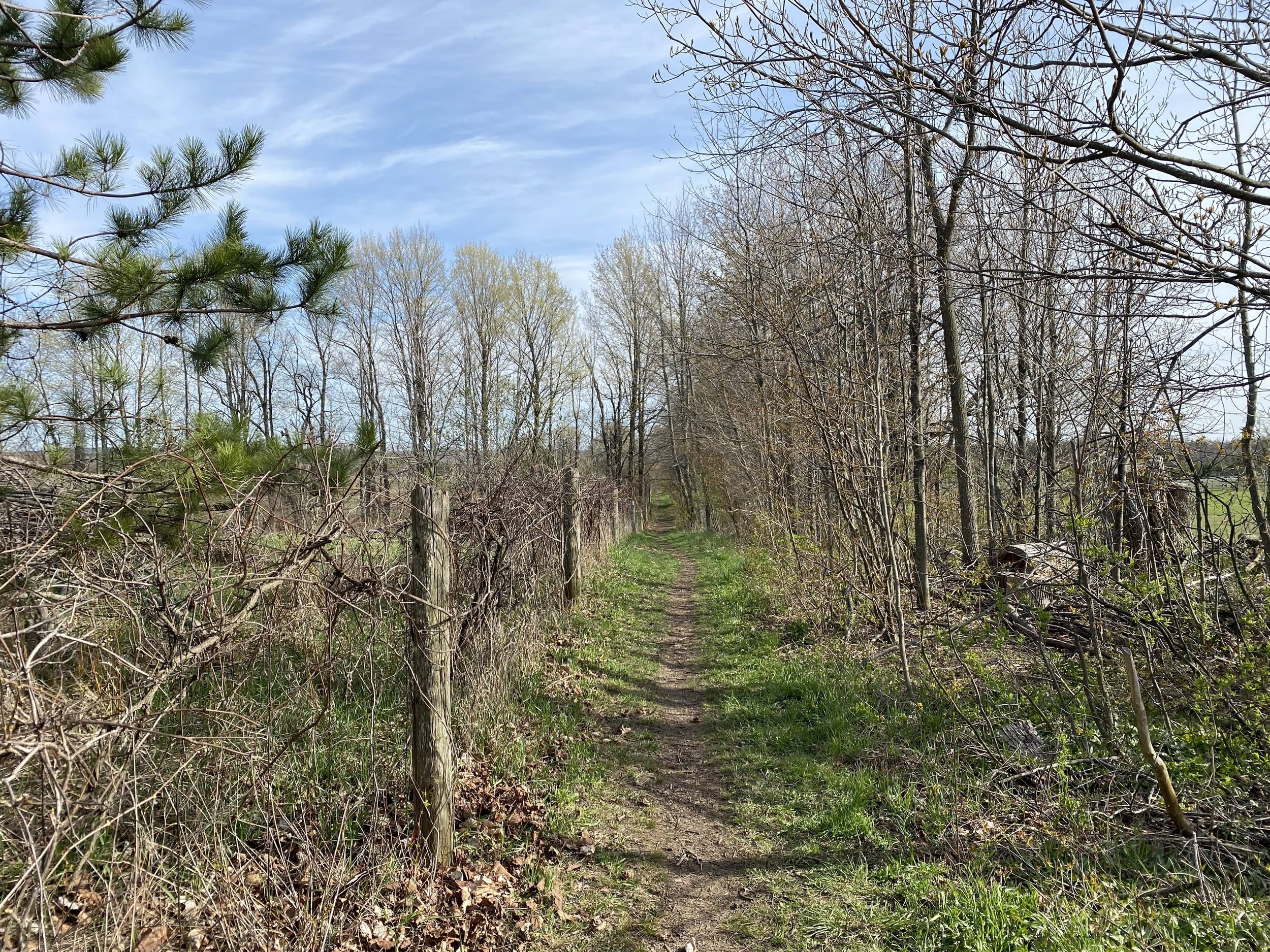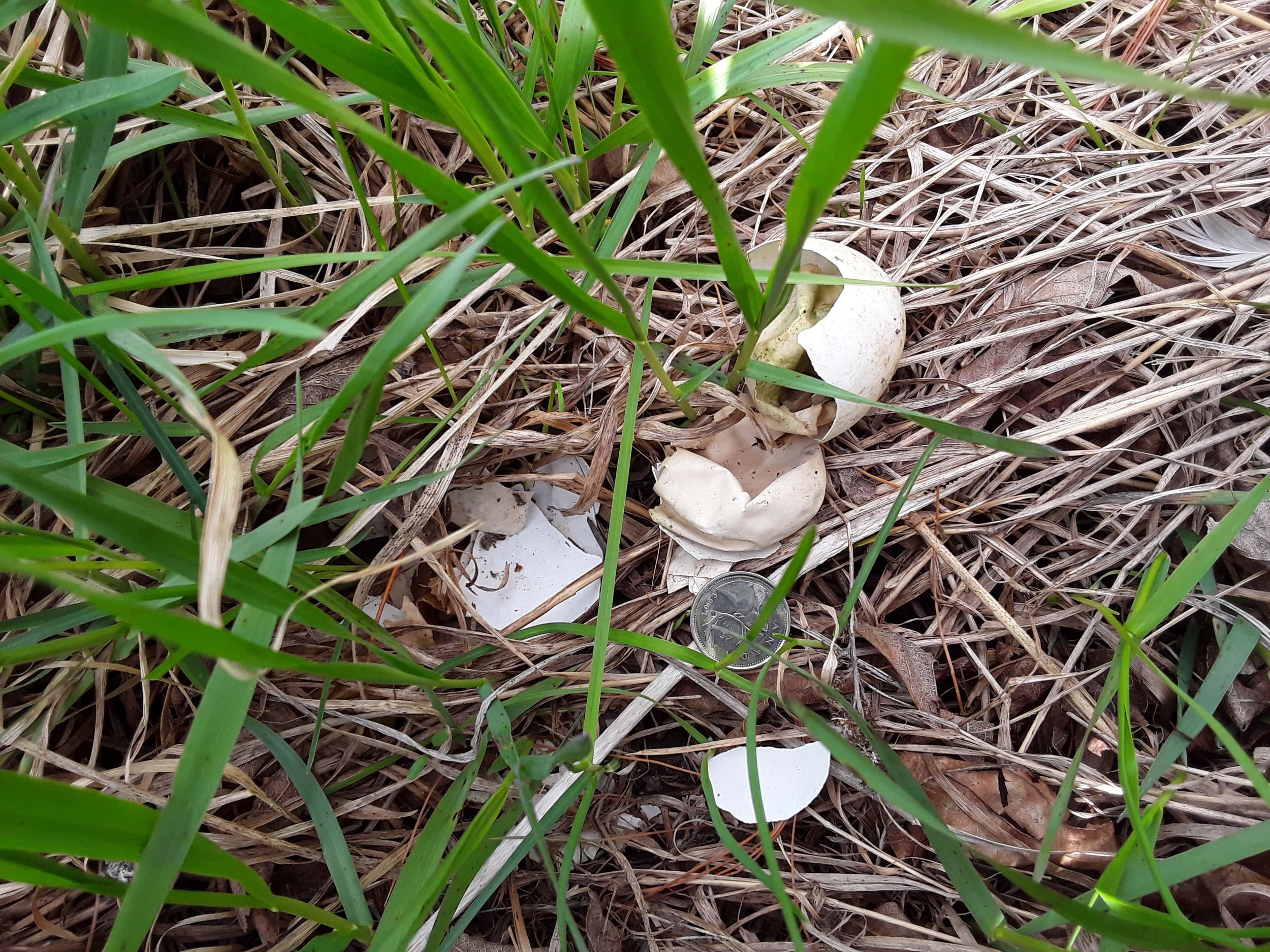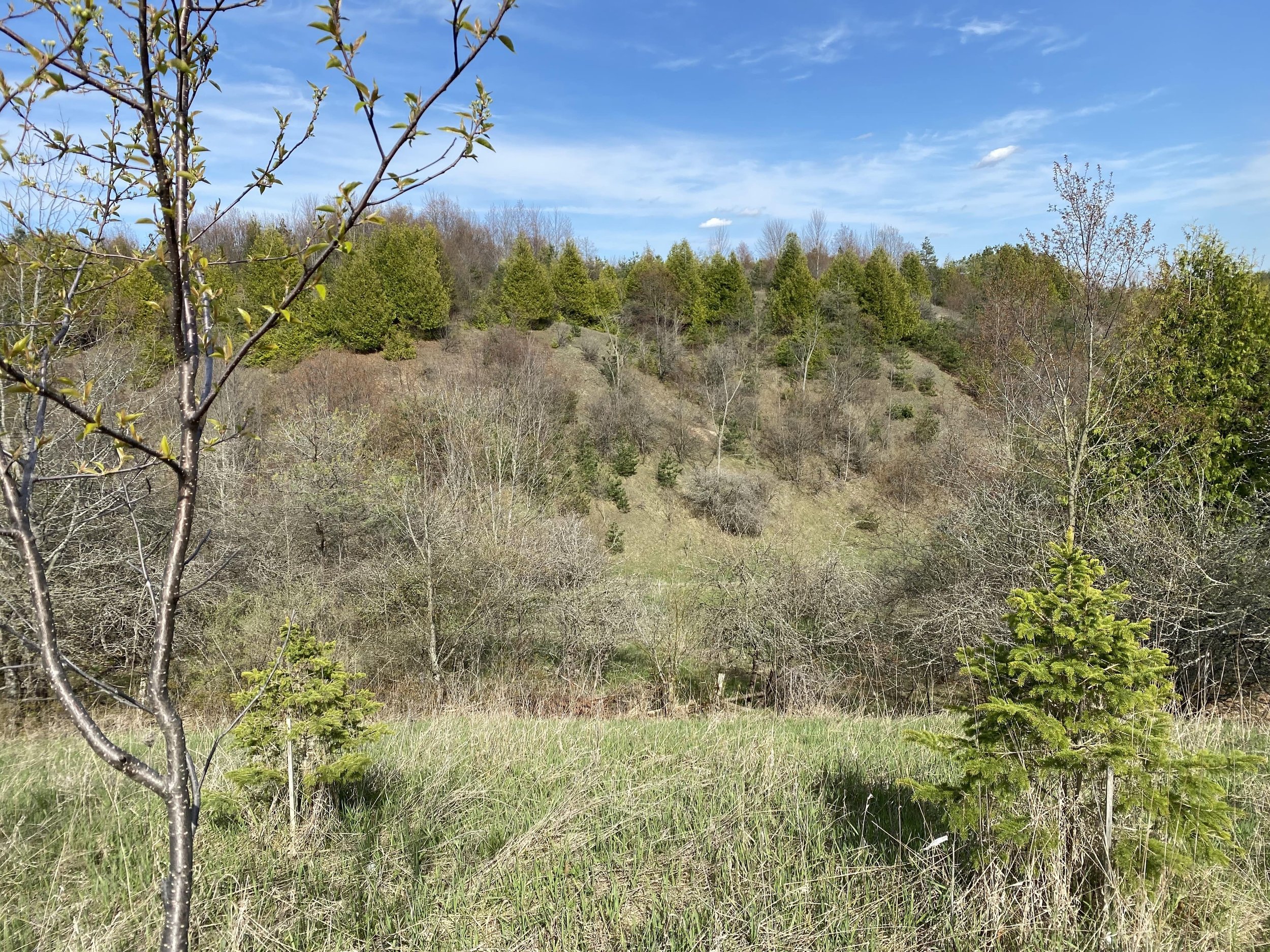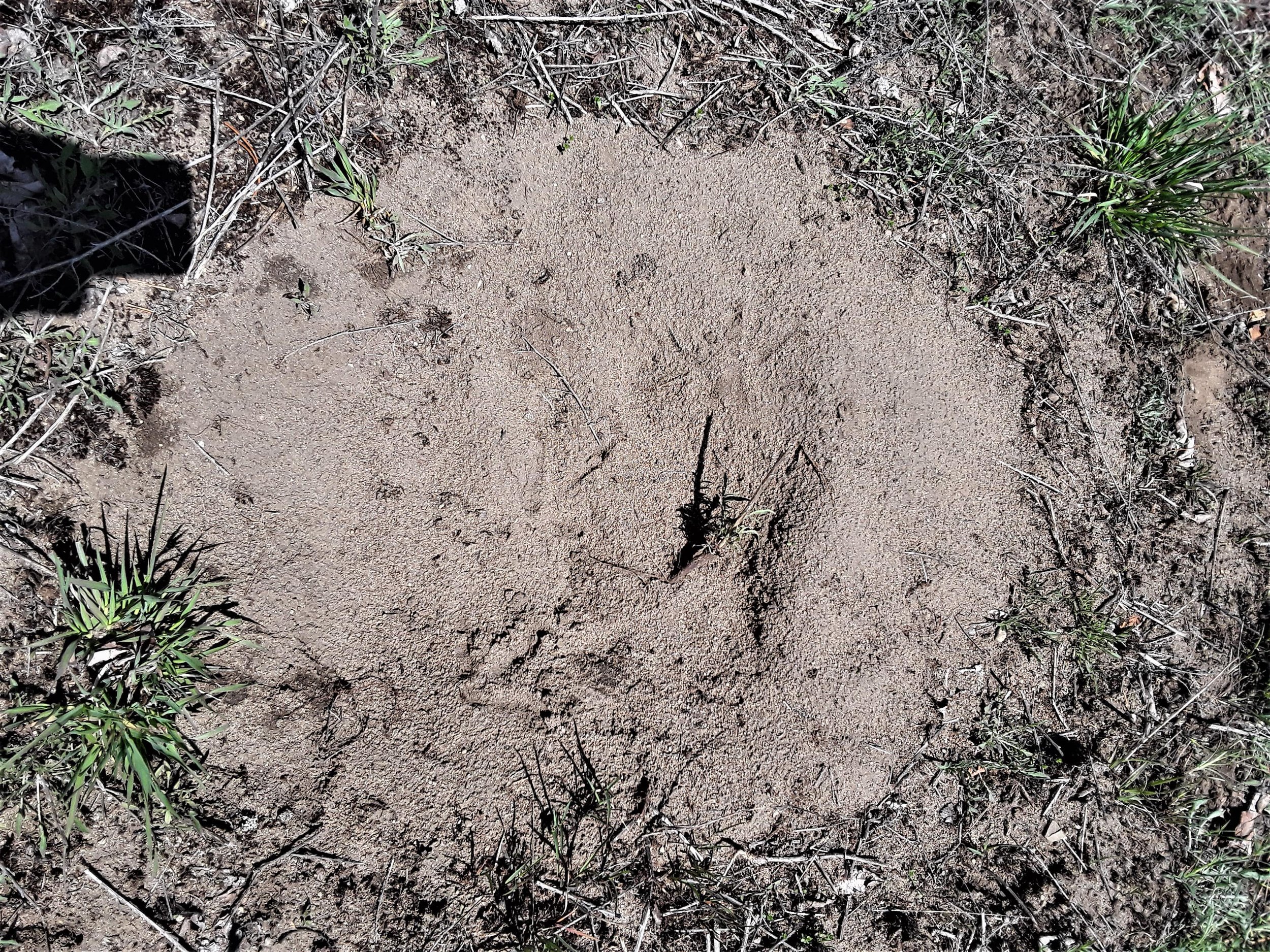The Spring Birds of Dunby Rd
For our first day of the 2023-2024 Earthtracks Wildlife Tracking Apprenticeship we all gathered at Dunby rd to explore the tracks and sign of wildlife along, and adjacent to, the Bruce Trail. While we encountered much more than birds, I wanted to write a bit of a report back on some of the sign of the birds along the trail as I am trying to focus on learning more about bird track and sign this year. This includes feathers, nests, eggs, scat, pellets, dust baths, kill sites, tracks, feeding sign, etc., etc. For this outing it all started with song.
Before we even got started, I was hearing a high whistling descending call, which I would name as swaying back and forth as it descended. “see-see-seeooee”. It was occasionally accompanied by a short rising “zeet… zeet… zeet…” reminiscent of the American Woodcock (Scolopax minor).
This was the Eastern Meadowlark (Sturnella magna), which I couldn’t sort out on my own. I needed help from Tamara and she pointed out that the “zeet..” call was an alarm of some kind. I have since looked it up and according to allaboutbirds.org this note is given “when humans or other meadowlarks intrude on their territory”, which we and others were doing as we walked down the path where the bird was singing. I really want to be practice hearing this song and call as in our area, this bird is considered threatened, and discovering a breeding pair would not only be a win for the birds themselves, but could also help towards saving an area from development or destruction.
Also along this trail was a more familiar but definitely still exciting call of the Eastern Towhee (Pipilo erythrophthalmus) who was hanging out on the other side of the fence row, hopping about on the ground with their mate, only to hop up on a low branch to occasionally sing out their song “drink-your-teeeaaaaaaa”.
I also tried to record a few other bird calls, but the audio recorder on the device I was using decided not to record everything, so I didn’t get all that I thought that I did. So I’ll move on from the audio and get into some of the other signs of birds which we encountered.
We sat down for our opening circle, getting oriented to the land we were going to explore and getting to know the program and each other a little. This is always the longest “sit down and chat” part of the whole course, but also an essential component for good community making. I do get distracted though, and start to notice a lot of the things growing around me, such as the Brome grasses (Bromus spp.), the Black Cherry (Prunus serotina) growing behind where I was sitting, and investigating a map of this section of the Bruce Trail. Turns out other people get to looking around them as well. When we got up from our opening circle I noticed a couple of folks investigating some feathers which looked like they had been sheared off, but as I got to really take a look it appeared that perhaps that wasn’t the case.
The group looked like they were a bunch of primary flight feathers from the right wing. The longest feathers were about 57 mm long, and the shortest (at the bottom of the group) were about 53 mm long. I ended up waiting for a chance to stop to check out Alexis’ copy of Bird Feathers (Scott & Mcfarland, 2010) and checked a couple of birds out. I should have gone with one of my important “rules” or “laws” of tracking because I could have saved a lot of time. “byron’s rule” states that the more common species should always be considered first before moving on to uncommon and rare species. Sometimes it is phrased as “it’s always a Raccoon until proven otherwise”. When I flipped to the page on Dark-eyed Junco (Junco h. hyemalis) it all came together. While a little small on the measurements, the colours and placement of colours were correct, especially noting the paler edge on the trailing vane. This identification was great to know. Remembering Tamara’s feather presentation from last year, I wanted to see what I could learn from the Junco’s feathers we’d found.
Junco’s are perching birds, as most songbirds are, and for many of the perching birds Tamara note that their wings are built for quick bursts of tightly controlled, highly manoeuvrable flight in brushy habitats. This would make sense as the bundle of feathers was found along a brushy trail side with loose rows of shrubs and trees along either side (see the first image above). I doubt this Junco got got too far from where this bit of the wing was found.
Following the trail South towards Hockley Valley Provincial Nature Reserve we came to a line of Scots Pines (Pinus sylvestris) where lots of cool things were discovered. Alexis found a bird scat full of chitinous remains of ant exoskeletons along a Rabbit (Sylvilagus floridanus) and/or Raccoon (Procyon lotor) trail. We could tell it was from a bird from the white coating of uric acid on the one end, as opposed to lizards, which we do not really have around here, and whose uric acid tends to be in small pouch alongside the scat as opposed to coating it. The question was which bird left it?
There are a couple of birds who like to consume ants, mostly woodpeckers, but I usually see differences in scat make up and associated signs. Pileated Woodpecker ((Dryocopus pileatus) scats are usually found at the base of the trees where they peck out their holes and scats around here are usually composed of the exoskeletons of the Black Carpenter Ants (Camponotus pennsylvanicus). This scat again was found on a trail, where I didn’t see much sign of Pileateds. Instead, as we walked through the fields adjascent to the path we were one, there were some noted ant hills, which of course were located on the ground. Are there any ground feeding, ant eating, scat leaving birds around the area we were tracking? There is one I can readily think of… The Northern Flicker (Colaptes auratus)! A ground feeding woodpecker who loves to consume ants. We had even heard them calling their long high rolling song “wikwikwikwikwikwikwikwik” which sounds similar to the Pileated. Perhaps paying attention to the calls of these two in the future would help me differentiate them better. As I have mentioned above that the Flicker spends most of its time on the ground, but this isn’t what I have observed. I mostly see them calling out from high up in the canopy of dead trees. I wonder if I am missing out on observing some really neat behaviours on the ground? Turns out while hanging out on the ground the Flickers love to probe anthills with their long tongues which are coated in a sticky substance, which helps them to lick up ants. John Eastman (Eastman, 1997) writes “[t]he sticky substance, strongly alkaloid, probably counteracts the formic acid the ants contain.” They also do a perform a fun behaviour called “anting” which they share with many other passerine (perching) birds. They grab hold of some ants with their bills, and begin rubbing the ants on their bodies (active anting), or as I have also heard, they just walk through the ant nests (passive anting) disturbing the ants until they begin shooting formic acid at the birds. There are a couple of theories as to why the birds do this. One that I had heard was that the formic acid acts as a bit of a pest control, inhibiting skin or feather parasites, or acting as a fungicide, keeping harmful fungi from becoming a problem. Another theory is that it is just stimulating to the skin in a way that the birds enjoy. It just feels good to them. I believe that both could be true. Other possible reasons include feather grooming and food preparation.
As we sat checking out the scat of the Flicker, we also checked out other scat, mammal scat this time, also full of ants. I think our best guess was Striped Skunk (Mephitis mephitis) but we aren’t certain. Skunk scat can be pretty amorphous, but are usually full of insect bits and break apart easily, which I observed with the scat that was found.
Back to the bird theme, a pellet was found at the base of the Scots Pines. I sadly didn’t get a photo of it intact, but it did measure 39 mm long, and I did take a keen look at some of the contents.
Of all the bones in the image, there are two I want to discuss, which I have begun to take a bit of an interest in over the years. I have found these bones many times before. I first really learned about this bone though from examining a Crow (Corvus brachyrhynchos) carcass many years ago at the edge of a small White Pine (Pinus strobus) plantation. All of the feathers were strewn about but all that was left were these bones. I recognized that they were not a skull (missing many factors which I use for i.d.) but I had no idea where on the body they were located. I guessed that they had something to do with the vertebrae, but I wasn’t certain.
I have since researched and come to understand that these bones are actually many bones fused together. The two bones I am describing in the image above are part of this fusion, though have probably broken apart in the digestive process of the owl that consumed them. The bones in the image above are the ischium (1) and the synsacrum (2), which is six abdominal vertebrae and seven sacral vertebrae fused together. Up to six caudal vertebrae (depending on the species) are missing from this specimen. The ischium are the lower “wings” that come out from the central vertebrae but again, have broken off during consumption or digestion. Again, the vertebrae, all fused are called the synsacrum. This is only found in modern birds (as opposed to prehistoric birds, reptiles, or mammals). Why are all these bones fused? This fusion makes it easier for the bird to walk and to fly, only having to keep the one larger bone structure rigid rather than many individual bones. It’s a genius move of evolution.
But what tiny bird did these bones come from? That is a question I cannot solve yet. I wonder if you can tell the species from the shape or width of the bones? I wonder if it was a younger bird, possibly a nestling, due to the fact that the fused bones came apart easier (the areas where bones fuse, the sutures, are weaker or less fused in younger animals).
Immediately after checking out the pellet we moved into an adjacent farmers field with a member of the Brassicaceae family growing in it. But the field wasn’t the focus, instead at the untilled edge in the NorthWestern corner we examined a couple of egg shells.
I had spotted these a couple of minutes earlier, but skipped over them as folks had called out about finding the scat and pellet, but I brought everyone back to examine the eggs and try and put together a bit of a story.
The eggs were large, slightly speckled with brown, broken, and the internal membrane had mostly separated from the shells. From the amount of broken pieces and the few large pieces I guessed that there were maybe two or three eggs that had been in this spot. I also noted that there was an older faded feather at the scene. The feather was narrow toward the base of the rachis where it met the calamus (the quill), and then broadened out further along the rachis and then ended sharply and horizontally at the top with some of the barbs showing wear or possible decay and loss of barbules.
Tamara began asking some questions which I took as a challenge to refine my thoughts, to express my observations in ways that made sense to others and to challenge my assumptions. The questions were very helpful in this clarifying process. The large size of the eggs could indicate a number of birds, but the most common in this area would have to be either Wild Turkey (Meleagris gallopavo) or Canada Goose (Branta canadensis), but the lack of water close by, nor the collected and built up pile of grasses and/or sedges in a slightly elevated or raised nest seemed to discount the Goose. Another point in favour of the Turkey would be the feather. It reminded me of the iridescent breast contour feather of a Turkey hen, but it had lost a lot of the iridescence. It seemed old, faded and pretty beat up. This, and the mildewy, dried algae covering the inner membrane of the egg pointed towards a clutch from last year.
Wild Turkeys can lay between 4 - 14 eggs, though the nests I have found contained five in the first, and ten in the second. They tend to lay one egg per day and then the Turkey hens leave their nest, only returning to lay another egg, before leaving again, spending their time between laying eating, roosting, and defecating. When they have reached the end of their laying period, usually after a one or two weeks, their brooding begins for the following 28 days. I believe from the signs left behind, the destruction of the eggs, that these eggs were laid early in the laying period, and the hen never got the chance to finish laying the rest of the clutch before it was predated. Noting the width of the arches in some of the larger fragments of the shells, I believe the predator to be a Raccoon (Procyon lotor). According to the paper “Interpreting Evidence of Depredation of Duck Nests in the Prairie Pothole Region” by Alan B. Sargeant (1998), Raccoons do not attack the hens who are on the nest. In regards to the presence of the breast feather, I wonder if the hen was just spooked off of the nest by the Raccoon? Of course this is hypothesis and conjecture, but sometimes that is what tracking is; working out the story without all of the information. Luckily there isn’t much riding on my analysis.
Although we had only made it so far it was already time for lunch. Over our break Alastair shared his experience at a Tracker Certification workshop/exam he had just done in Quebec. Every story I hear of these certifications gets me excited for the one I am signed up for in October in Ohio. I hope to continue to study hard over the next few months so I will come prepared and ready. Even this post is a reflection of that studying, hoping to expand my awareness of track and sign of birds. I hope to also brush up on reptiles and amphibians, my lefts and rights, and all the other things I need to cover. I just need to keep tracking, visiting muddy spots and seeing what I can see, and learning to see what I cannot.
After lunch we started down the hill towards the shady Eastern White Cedar (Thuja occidentalis) seep but had to stop along the way to check out some sandy circles on the South side of the hill.
First thing I noticed were some larger bird tracks with toes 2, 3, and 4 visible, but 1, the hallux, not so visible. Also notable was the impression of the metatarsal pad, the point where all of the toes come together and meet the leg. If I am remembering correctly, the length from the tip of the claw of toe 3 to the far end of the metatarsal pad was ~95 mm (3¾ in). This leads me to believe this is was the track of a Wild Turkey hen, though a small one. In Mark Elbroch & Eleanor Mark’s Bird Tracks and Sign (Stackpole Books, 2001) sizes for Turkey tracks range from 95 - 127 mm (3¾ - 5 in). While talking about these tracks Alastair reminded us all that a male Wild Turkey, a Jake, will have a wider toe 3 than a female Turkey. He mentioned that if the width of toe 3 is greater than 12.7 mm (½ in) than it would be a male. Less than 12.7 mm (½ in), it would be a female. These particular tracks were on the smaller side of 12.7 mm (½ in), so again, they were likely from a female.
The size of the sandy patch felt like it was about 60 cm (23⅝ in) in across. It was assumed that this was the Wild Turkey dust bath. Although the measurements for this particular dust bath are larger than the measurements offered in Bird Tracks and Sign, but I think my memory is fairly accurate. Perhaps the Turkeys don’t read the manuals.
I didn’t get a good enough photo, but we also noticed in another dust bath that there were Corvid tracks. We took a moment to look at how toes 2 and 3 are closer together than toes 3 and 4 are, but we also took measurements to figure out which of the larger Corvids made the tracks as both American Crows (Corvus brachyrhynchos) and Common Ravens (Corvus corax) hang out in the area. We measured the distance between the tip of the claw of toe 1, again, called the hallux, to the tip of the claw of toe 3. This measured 76 mm (3 in) in length, which led us to believe that this was a Crow as anything under 95 mm (3¾ in) would be a Crow and anything over 95 mm (3¾ in) would be a Raven. For a more in depth look at Crow and Raven tracks, check out a post I made in the Winter.
We saw a lot more cool stuff throughout the rest of the day together including some Crow and Ruffed Grouse (Bonasa umbellus) feathers which appeared to be sheared off their bodies from a higher elevated log, perhaps the sign of a larger mustelid? As well as a skull find, and a White-tailed Deer (Odocoileus virginianus) leg hanging from a tree as we were walking back to the vehicles. It’s amazing the discoveries we find when we take the time, and set the intention to look with a community of trackers.
I also want to offer a big thanks to Tamara Anderson for her mentorship and inspiration for learning more about birds. She has answered and not answered many of my birding/bird tracking questions for many years, encouraging me to go out and keep learning on my own. I truly and deeply appreciate it. Thank you so much, Tamara!
To learn more :
Bird Feathers by S. David Scott & Casey Mcfarland. Stackpole Books, 2010.
Ask Tamara
Manual of Ornithology by Noble S. Proctor & Patrick J. Lynch. Yale University Press, 1993.
Synsacrum of Fowl video
Interpreting Evidence of Depredation of Duck Nests in the Prairie Pothole Region by Alan B. Sargeant et al, 1998.
Bird Tracks and Sign by Mark Elbroch & Eleanor Marks. Stackpole Books, 2001.








